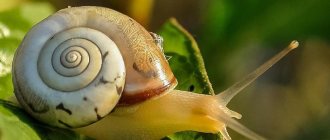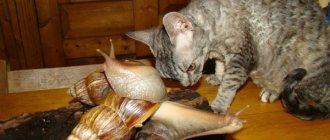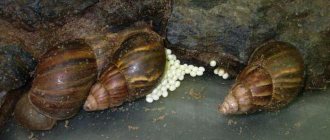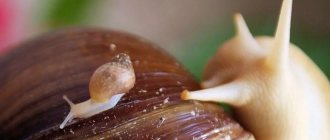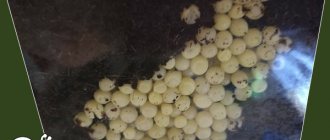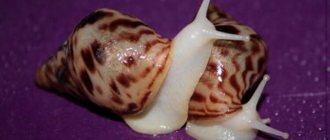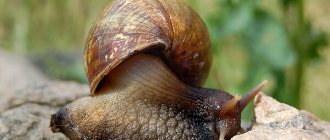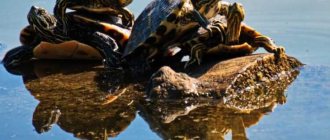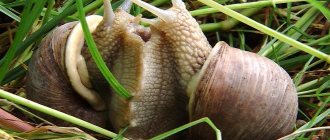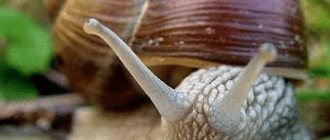Recently, snails have become increasingly common as pets. You can buy these exotic animals as a pet from a breeder or at a pet store. And for cooking - in a grocery store or on special farms. At the same time, many people have a logical question: how much does an Achatina snail or another type of mollusk cost?
Reproduction
Sex differences
The Achatina snail has both female and male genital organs. The main difference can only be in the size of the snail, since if the mollusk is small, it will act as a male, and if it is larger, then it will be a female and lay eggs.
Getting offspring
Achatina at home reaches sexual maturity at the age of about 1-2 years.
- Each snail can perform both female and male functions, that is, it is a hermaphrodite. Before mating, the snails look closely at each other for two hours. If the Achatina are close in size, then they are both fertilized, and if one is larger than the other, then the large snail acts as a female. Small snails are almost always male, and eggs begin to be produced only when they increase in size. Achatina can store seminal fluid after mating for almost two years, using it to fertilize its eggs. At one time, the snail lays approximately 250 eggs 6 times a year. The dimensions of Achatina eggs are 0.5 cm and have an oval shape. Under favorable conditions, small snails (about 5 mm) hatch within 2 weeks.
- Also, Achatina can reproduce independently, without a partner, this usually happens in extreme conditions, when their species in a specific territory disappears to the number of one individual
- Achatina can distinguish between owners and strangers;
- These snails move about 1 cm per minute;
- The mollusk has about 30 thousand teeth with which it grinds food;
- The main activity is shown at night;
- When Achatina gets scared, they can make a squeak, similar to singing;
- Snails smell with their horns, since that is where their olfactory receptors are located;
- The Achatina brain contains about twenty thousand neurons, which significantly distinguishes them from the primitive snail;
- In the absence of food or in dry air, they hibernate.
Ability to reproduce
Achatina reticulata is capable of producing numerous offspring. Already at 9 months she can make her first clutch. At one time, the snail hatches up to 250 small mollusks. This is a fairly large number, so not everyone is ready to keep so many pets. If offspring are not needed, then the eggs should be destroyed.
If you want to raise babies, you will need to place all the eggs in a separate container. But you cannot transfer them by hand, because the heat emanating from a person leads to the death of the embryo.
2 weeks after laying, the babies will appear. They must be transferred to a separate container and ensure optimal temperature and humidity. But they must be kept separate from their parents, since they are able to feast on their young. Read this detailed article on how to care for small snails.
Achatina reticulata snails are an unusual and beautiful species of snail. The presence of such an animal in the house is truly exotic, uplifting and creating a unique atmosphere.
Features of behavior
Vechernitsa: cultivation, care, types and varieties
People tend to believe that snails have no brains and cannot think. This may be partly true, but it is quite possible to develop reflexes in a snail. Those who have kept Achatina claim that they can easily be taught to eat at the same time if they are given a bowl of food at the same hours.
It is believed that Achatina is active at night, so it is better to feed them in the evenings. They also easily remember the location of the bowl. In addition, owners speak of them as curious and clean creatures. Achatina is not afraid of humans and will happily crawl across your palm if you pick it up.
Overall, this is an ideal pet: it doesn’t make noise, doesn’t smell, doesn’t bother you, and is interesting to watch. You can buy Achatina very cheaply from amateur breeders through advertisements on Avito and other similar sites. The owners will be only too happy to place numerous offspring in good hands.
What is the price of snails
Many have come across advertisements for the sale of these exotic pets. The cost of pets can vary greatly. Let's figure out how much a snail costs in a pet store and from private breeders.
The price of a shellfish will depend on the following factors:
- species and subspecies A rare species will cost more than a common one. For example, Megalobulimus oblongus is more expensive than the snails we are used to - the grape snail and Achatina fulica.
- albino forms will cost more.
- size is also a decisive parameter. A large individual with a beautiful shiny shell will cost more than a small and possibly non-growing one.
- a snail from a professional breeder is also more expensive. Because, as a rule, breeders carefully select individuals. They do this to obtain healthy offspring, without genetic diseases and with beautiful appearance. Naturally, such animals will be more expensive than pets obtained from uncontrolled mating of related snails.
- The age of the snail also influences. The price of adult snails will always be higher than that of newborn snails. Because to raise a healthy and strong pet you need to spend your time and effort.
- Based on the above, the next factor emerges - maintenance and care costs. Keeping and breeding any pets requires costs. Therefore, the more a breeder invests in a snail, the more expensive it will be. Therefore, rare and capricious pets, for example, Achatina Zanzibarica, are more expensive than unpretentious fulikas.
Types of snails Achatina
Katran: description, types, cultivation, beneficial properties, photos
In nature, there are more than 100 species of Achatina snails. The description and classification of African land mollusks is still underway.
Akhatina Fulika
Description of the species: The shell is brown and yellow, the size of an adult Achatina is 15-20 cm, weight is about 300 g.
Massive body beige or brown.
Varieties of Achatina fulica
- Achatina fulica albino - white body with yellow shell;
- Achatina "white jade" - white body with a brown shell;
- Achatina fulica rodatzi - beige body with yellow shell;
- Achatina fulica hamilei - brown body with brown shell.
Fulika albino
Fulica white jade
Fulika rodatiya
Achatina fulica
Features of the snail: Active, beautiful, curious and friendly mollusk. In many countries, Achatina fulica mucus is used for cosmetic and medicinal purposes. Undemanding in care, loves to swim.
Reproduction: Reaches sexual maturity at 6-7 months. The mollusk is very prolific; one snail can lay up to 1000 eggs in a year. The average life expectancy in captivity is from 3 to 7 years.
Fulics get along well with other species of Achatina in the same terrarium.
Achatina Reticulata
Description of the species: the shell is spotted, brown-beige in color.
The size of an adult animal is about 20 cm, weight 250 - 300 g. Within the species, the reticulum varies in body color.
Varieties of Achatina reticulata
- Achatina reticulata albino - white body with marbled color;
- Achatina reticulata standard - beige body with mottled brown shell;
- Achatina reticulata dark head - Black head, brown body, dark marbled shell.
Albino reticulata
Reticulate standard
Achatina reticulata
Achatina reticulata
Features of the snail: It differs from other species of Achatina by its ribbed shell, it is an active, curious and friendly snail. Keeps you active throughout the day. Recognizes owner by smell.
See also:
Reproduction: Becomes sexually mature at 9-12 months. Prolific, lays 100-200 eggs in a clutch. Young reticulata are very nimble and curious snails, so chips and cracks on the shell are very common. The average lifespan of a mollusk in captivity is from 4 to 6 years.
They get along well with snails of their own species and Achatina albopicta.
Achatina tiger
Description of the species: barrel-shaped shell of yellow or orange color with dark stripes. The size of an adult animal reaches 25 cm in length, weight is about 500 g. A specimen of the tiger snail was included in the Guinness Book, it weighed 900 g and was 39.3 cm in length.
Varieties of Achatina vulgaris
- Achatina achatina albino - white body with yellow shell;
- Achatina achatina standard - brown body with a striped orange shell.
Tiger snail
Achatina vulgaris
Achatina Achatina
Achatina tiger
Snail Features: Tigers are calm and gentle snails. They eat well, are not very active and only come out of hiding in the evening. Demanding on soil and nutrition.
Reproduction: They reach sexual maturity at the age of two years. The snail lays about 200 eggs in a clutch. In captivity, it lives from 5 to 7 years.
It is not advisable to keep the tiger snail with other types of African snails.
Achatina immaculata
Description of the species: oblong light shell with dark spots and stripes. The size of an adult immaculata is 15-17 cm in length, weight 200 g.
The leg is beige or gray in color; a characteristic dark stripe stretches from the head to the base of the shell.
Varieties of Achatina immaculata
In nature, there are two more subspecies of immaculata. This is a two-color Achatina immaculata and Lamarckian immaculata, but in our country they are not grown at home.
Immaculata two-color
Immaculata panther
Achatina immaculata
Immaculata Smitty
Features of the snail: active, inquisitive and fearless, but they are demanding of humidity and temperature conditions. When there are sudden changes, they go into hibernation.
Reproduction: The immaculate becomes sexually mature at 6-7 months. Cases of self-fertilization of mollusks are described in the literature. There are about 200 eggs in the clutch. The average lifespan of an animal is from 5 to 7 years.
It is not advisable to keep Achatina immaculata with other types of snails; they often show aggression towards them.
This is interesting: Caring for Achatina snails - a description of how to care
Large domestic snails Achatina
These are one of the largest mollusks in the world that live on land. They have huge shells of light brown color, on which there is a peculiar pattern. The shade of the shell can vary, it all depends on what the snail eats. Its body is covered with tubercles and is light or dark in color. The longest shell of this mollusk was about forty centimeters, and the weight of the snail was equal to six hundred grams. They are able to move quickly. Photos of mollusks are available in every pet store.
Is it worth starting?
Achatina is not picky about its contents and nutrition. They are contact molluscs and are easy to tame. Over time, they begin to recognize their owner by smell, and they develop conditioned reflexes. Fruits and vegetables are chosen as food for pets, but snails need protein and calcium supplements.
These exotic pets are quite smart and quick-witted. They move quickly, making them interesting to watch.
Where to buy Achatina snails?
Today it is not difficult to buy Achatina snails. Almost any pet store has them for sale. You can also order an exotic pet online.
When purchasing shellfish, experienced managers will give advice on their selection, care and nutrition. Pet stores always have a wide range of large shellfish. They can be of different shapes, sizes, as well as types and colors. At the same time, you can find both 2-week-old individuals and adult representatives of the fauna. They can also be bought and even taken free of charge from private breeders. To do this, you can use an electronic bulletin board.
How much does the Achatina snail cost?
The cost of snails depends on their size. Basically, small individuals can be purchased for one hundred rubles, the price of adult individuals will be about two hundred and fifty rubles. Some owners can give away their pets for free, since they reproduce quite quickly and there is not enough space for them in the terrarium.
Benefits of domestic Achatina snails
Achatina is widely used in cosmetology, as it has amazing properties. They heal the skin, nourish it, and start the process of renewal of epidermal cells. Antioxidants contained in shellfish stop premature aging of the skin, moisturize it, smooth out wrinkles, and bacteriophages help protect against harmful microbes.
All these components are contained in the mucus that mollusks produce.
Thus, this mucus has many medicinal properties:
- elimination of wounds and burns;
- restoration of skin cells;
- rejuvenation;
- elimination of small wrinkles;
- whitening and moisturizing of the skin.
Also, the snail is often used in the treatment of diseases of the bronchi and lungs.
How to identify an Achatina snail?
There are many varieties of Achatina snails. Adults usually reach a size of twenty centimeters. They have a powerful body of a light or dark shade, covered with tubercles. The color of the shell can vary from yellow to brown. The shell of the mollusk is spotted and may be ribbed.
How to determine the sex of Achatina?
It is generally accepted that Achatina snails are hermaphrodites. However, they cannot give birth without the participation of another mollusk.
The largest adult individuals are considered females, while males are smaller. If there is only one clam available, then a pair for it must be selected in accordance with the size of the clam.
In some cases, when there are two snails, no offspring are observed. But it happens the other way around, when each individual begins to lay eggs.
How to determine the age of Achatina?
It is necessary to pay attention to some signs that can help determine age. These include:
- The genital organs, which are located on the neck near the head. While the snail is small, they are invisible. By six months, a small tubercle of a light color appears in this place.
- Coils on the sink. The older the mollusk, the more coils there are on the shell. For example, by the age of nine, there may be about nine turns on it.
- Shell color. Over time, the shell of Achatina begins to turn green.
- Ability to reproduce. Those mollusks that are less than twenty-five weeks old do not have the ability to lay eggs. Therefore, the presence of eggs on the spiracle indicates that the snail is already six months old.
- Food preferences. Young clams love living plants, while old clams love rotting plants.
What to call Achatina?
The Achatina snail is a bisexual creature, so there should be no problems choosing a name for your pet. You can name your exotic pet either a male or a female name, it all depends on the preferences of the owner.
Diseases
Kiwi (actinidia), (actinidia). description, types and cultivation of kiwi. medicinal and other beneficial properties of kiwi
Achatina rarely gets sick. With a lack of calcium, the shell is destroyed. Injury may occur if dropped or handled incorrectly. Never pick up a snail by the top of its shell; let Achatina fulica crawl onto your hand on its own. If your snail is chewing on a shell, adjust its diet and make sure your pet has enough free space. In unsanitary conditions or poor ventilation, snails are susceptible to parasites. If the snail refuses food, becomes lethargic, a white coating appears on the shell, or small translucent worms are visible near the snail’s body, immediately remove the sick individual. Rinse the terrarium thoroughly and replace the soil.
Expensive or cheap?
When buying online via the Internet, you cannot know the condition of the pet, its pedigree and its contents. Therefore, the cost of a snail at 500 rubles per exhausted animal is expensive.
But buying a well-groomed pet from a professional breeder for 500 rubles can be cheap. But usually breeders sell their pets at a higher price. Why is this so?
The snail breeder is engaged in the selection of healthy individuals, including natural ones, and the selection of a pair. He never treats his pets lightly, quarantines them, and waits until they reach sexual maturity to breed them. All this time, the pets receive good care and eat properly. After laying and obtaining offspring, careful selection and culling is carried out. After which the healthiest and largest offspring are put up for sale.
If it is expensive for you to buy a healthy snail from a breeder, you can find advertisements where they give away pets for free. But in this case, be prepared that the snail may not grow or will not grow large.
Feeding and water
The clam should always have calcium. Edible chalk, sepia, eggshell, shell rock.
All these products can be purchased at any pet store or online. Snails need them for shell growth and proper development. Recipes for nutritional supplements for rapid snail growth.
Vegetables and fruits
- Lettuce leaves
- Broccoli
- Cauliflower
- Tomato
- Carrot
- Apple
- Pears
- Clover leaves
- Pumpkin seeds
- Raisin
- Turnip
- Peas
- Mushrooms
- Cucumber
- Celery
- Strawberry
- Watermelon
- Banana
- Raspberries
- Zucchini
- bell pepper
- Sweet corn
Water for Achatina
Place a plastic bowl of clean drinking water in the terrarium. Snails will not only drink from it, but also swim. Monitor the purity of the water and the depth in the container
Read about the importance of water for snails here
Young growing snails need to be fed every day, and adult snails - 2 times a week, but they can also withstand a week-long fast without harm to their health. Snails are unpretentious in food; they are suitable for:
- leaves of cabbage, lettuce, spinach, other greens;
- cucumbers, tomatoes, pumpkin, zucchini and other vegetables;
- carrots, potatoes, rutabaga and other root vegetables;
- dandelions, yarrow, plantain, other lush greens;
- apples, pears, peaches, bananas and other fruits.
What to feed pet snails?
In order for a snail to live long, it is also necessary to provide it with proper nutrition. Many breeders recommend including the following products in your pet's diet:
- boiled eggs;
- fresh vegetables and fruits;
- legumes;
- mushrooms.
It is recommended to alternate these foods to keep your diet varied. For calcium, shellfish are given crushed eggshells and chalk. You can buy a mixture of vitamins and minerals for Achatina at any pet store.
If your pet is still small, you can give him dried gammarius - small crustaceans that are rich in calcium. It can be purchased at almost any pet store.
Newborn clams are given carrots, which are first thinly cut into strips. After three days they can be given an apple and salad.
How to care for and maintain Achatina snails
When choosing a pet, you need to rely on your taste and the characteristics of each species. Most often in home terrariums live: Achatina fulica, reticulata and immaculata. They are unpretentious and omnivorous, very friendly and sociable. They are interesting to watch. But for their comfortable stay, you need to take care of some nuances.
Container
The Achatina snail is kept at home in a terrarium, a plastic container or a rectangular aquarium, which must be equipped with a lid. The volume of the selected container should be at least 10-15 liters per snail
It is important to remember that the larger the terrarium, the larger your pet will be
Be sure to take care of the ventilation holes in the container or aquarium. Fresh air is necessary to prevent waterlogging of the soil, mold and mildew.
Litter
The African snail is a land mollusk, so you need to put high-quality bedding on the bottom of the terrarium. After all, Achatina spends most of its time buried in the ground
It is important that it is moderately moist and loose. Many snail breeders use:
- coconut substrate;
- sphagnum moss;
- padding mat;
- thoroughly washed flower soil.
Sometimes on forums, novice snail breeders are advised to use sand, sawdust and even small pebbles as soil. This absolutely cannot be done. Sand, sawdust and stones lead to injuries, suppuration and abrasions of the sink.
Nut shells and membranes are poured into the terrarium as bedding. However, despite their organic nature, the shells do not absorb water. It accumulates at the bottom of the terrarium and causes the appearance of midges and nematodes.
How to set up a terrarium for Achatina
To make snails feel comfortable and free, it is important to choose and arrange their housing correctly. Special soil is poured into the terrarium and a small pool is installed for bathing the snails. It is also important to monitor the humidity and temperature conditions in the terrarium.
Choosing a terrarium
In order for the snail to feel free, it is recommended to purchase it a home at the rate of ten liters per individual. After all, the larger the house, the larger the clam will grow. It is recommended to buy a twenty-liter terrarium with a lid for a family of mollusks.
Soil selection
The soil should be soft and loose, because the mollusks will burrow in it. The soil is poured in a layer of five or ten centimeters. You cannot use soil for plants, which is sold in many stores. The pet store sells coconut substrate in briquettes. It is poured with boiling water and cooled, and then placed in a terrarium. Instead, high-moor peat is often used.
How often to change the soil
The terrarium is cleaned once a week, the glass is wiped daily without using detergents. The soil must be changed once a year.
Maintaining optimal humidity
It is recommended to regularly moisten the soil, since snails often burrow into it. If the soil is very wet, the snail will sit on the wall of the terrarium for a long time. If it is very dry, the mollusk hides in the shell.
The temperature in the terrarium should be from twenty-five to twenty-eight degrees Celsius. If it does not comply with this, the snail will hibernate. An incandescent lamp can become a source of heat and light; there is no need to buy special equipment.
Population and species status
Photo: Achatina snails
The conservation status of the Achatina species is normal, that is, the species is not threatened. The population of the species is extremely numerous, the mollusks feel good in their natural habitat, reproduce well and extremely quickly and fill new territories. The species is highly invasive, which means that the species is able to quickly adapt to new environmental conditions, invading ecosystems uncharacteristic for this species.
Many countries have introduced a ban on the import of Achatina, excluding the introduction of these mollusks into ecosystems alien to them. Achatina are dangerous agricultural pests; snails eat crops, fruits and vegetables on farms. The presence of Achatina in large numbers in an ecosystem alien to them can become a real disaster for the agriculture of this area.
In recent years, in our country they like to keep these creatures as pets. After all, snails are unpretentious, calm, and many people take great pleasure in watching these creatures. Often the snails are farmed and the young are given away free of charge. However, do not forget that in no case should you simply throw away snail eggs, because Achatina can hatch and quickly spread to a new territory.
In our country, Achatina usually does not survive in the wild, so there is no ban on keeping these pets. In the United States, importing snails into the country is punishable by up to 5 years in prison, and imported snails are destroyed. It is also prohibited to import snails into the territory of many other countries where quarantine is in effect.
The Achatina snail is an amazing creature. Snails are very adaptable and easily survive the negative influences of the external environment. They quickly acclimatize and colonize new territories. They are suitable for many as pets, because even a child can take care of Achatina. The harm from snails lies in the fact that they are carriers of parasites that can become infected. Therefore, having decided to get such a pet, you should think several times whether it is worth doing or not.
Tags:
- Achatininae
- Achatina
- Achatinidae
- Gastropods
- Ancient animals
- Animals of Africa
- Animals of India
- Animals of Ireland
- Animals of Kenya
- Animals of Mauritius
- Animals of Malaysia
- Animals starting with the letter A
- Animals starting with the letter U
- Animals of New Guinea
- Animals of Russia
- Animals of Somalia
- Animals of the Subtropical Zone of the Northern Hemisphere
- Animals of the Subtropical Zone of the Southern Hemisphere
- Animals of the Subequatorial Belt of the Northern Hemisphere
- Animals of the Subequatorial Belt of the Southern Hemisphere
- Animals of Thailand
- Animals of the Tropical Zone of the Northern Hemisphere
- Animals of the Tropical Zone of the Southern Hemisphere
- Animals of the Temperate Zone of the Northern Hemisphere
- Animals of the Temperate Zone of the Southern Hemisphere
- Animals of Sri Lanka
- Animals of Ethiopia
- Interesting animals
- Pulmonary snails
- Shellfish
- Unusual animals
- Stalk-eyed
- Herbivores
- Amazing animals
- Exotic animals
Description
The homeland of Achatina fulica is East Africa, its range has spread to other continents. In some countries, keeping and breeding snails is prohibited. Representatives of the fulica species have different colors: the shell is light or brown with a yellow or reddish pattern. The shell is conical in shape and consists of 7–10 whorls. The body can be light, yellowish and dark. There are 4 tentacles on the head: the long ones serve as eyes, the short ones serve as a sensory organ that helps to perceive odors. The sense of smell is well developed.
Behavior
The active period of Achatina fulica occurs at night; the snails feed and crawl along the walls of the aquarium. During the day, mollusks sleep, hiding in a shell. Adults are less mobile than young ones. Snails are capable of covering long distances. They are not a gregarious species; communication between individuals occurs during mating. The olfactory organs play a major role in the perception of the surrounding world.
Life cycle
Sexual maturity occurs at 6–15 months. Achatina fulica is a hermaphrodite. A minimum of two individuals are required for mating. A large snail acts as a female. Self-fertilization is possible in rare cases when the population is low. A fertilized snail can produce offspring over the next 2 years. There are 200–300 eggs in one clutch, which Achatina can lay every couple of months. Achatina fulica grows actively for 2 years, then growth slows down. They do not need to hibernate.
Subspecies
There are several varieties of Achatina fulica that are kept at home. Subspecies differ in body and shell color.
Standard
Common shell colors for Achatina fulica are sand with several brown stripes and plain brown. The columella (the border on the right edge of the shell mouth) is white or bluish. To accurately determine the subspecies fulica, it is necessary to examine the columella, which is covered by a mantle in young snails, but is quite clearly visible in adults. The body color of Achatina fulica is standard from beige to black-brown. There is also a species with a white leg - Achatina fulica albino.
Hemeli
Latin name of the subspecies: Achatina fulica var. hamillei. It differs from the simple Fulika in the color of its apex; Hemeli’s apex is pink.
Rodation standard
In Achatina fulica var. hamillei f. Rodatzi light sand shell with yellow stripes. The body of Achatina fulica is dark with light inclusions. There is also a light type - albino rhodium.
Albino body
Albino body (White Jades) is an albino form of snail, characterized by a white body and the absence of visible pupils. Albino coloring is found in almost all species of Achatina and Archachatina.
Description
Translated from Latin, the name “Achatina immaculata” is translated as “flawless” or “unsullied.” Thus, a parallel is drawn with the breeding characteristics of these snails. As is known, they reproduce by self-fertilization, so we can make a reference from the name of the mollusk to the immaculate conception.
A distinctive feature of Achatina immaculata is its small shell, which has a rather smooth structure. The shape of the shell is cone-shaped, the narrowing is smooth, with a pointed apex, usually of a sandy or pale beige hue. The total size of the shell varies from 10 to 15 cm, in adult mollusks it has about 7 whorls, with the very first ones being light, but darkening as they move away - the very last whorl is distinguished by a rich dark brown color with a pronounced reddish tint, even stripes without any or stains.
The columella is usually pinkish, purple or crimson in color. The body is beige with a slight red tint. There is a smooth light brown stripe along the surface of the neck. The leg is quite soft with a pronounced network-like pattern, the horns are shortened.
In nature, Achatina immaculata lives in the east of the African continent, but it can be found in many other corners of the globe. Thanks to its unpretentiousness to living conditions, it thrives in home terrariums.
There are 3 types of immaculates:
- panther;
- Lamarckian;
- two-color.
All of them can coexist with each other, as well as with reticulata and fulicas, however, several species should be planted in one container with caution, constantly keeping the relationships of individual individuals under control - immaculata can bite their neighbors, and the victims of the attack experience stress, which leads to delayed growth and development
Feeding
Plant foods predominate in the diet:
- non-acidic varieties of apples;
- cucumbers;
- lettuce leaves;
- bananas;
- beet;
- potato;
- tomatoes;
- carrot.
Calcium, necessary for maintaining the strength of shells and normal growth, fulica is obtained from eggshells and special chalk. Grind them into powder. Calcium supplement can be placed separately or sprinkled on food. Calcium should always be available.
You can also give sepia - this is what snail breeders often use. The main thing is that there are no artificial additives or dyes.
Add protein food (dried gammarus and daphnia) less often. If a snail stops eating protein, it may get sick. You need to give a pinch of protein food 1-2 times a week.
It is not recommended to serve spicy, sour, sweet and salty foods; such foods can lead to the death of the mollusk.
Diet of Achatina reticulata
Achatina reticulata have a good appetite; they are not picky about food. But you can’t feed them to everyone. There are products that can undermine the health of animals. These include sweets, salt, flour, semolina porridge. Consumption of these products can even lead to death.
In order for Achatina to be healthy and have an attractive appearance, it is necessary to feed it with calcium and protein. To get the first element, pets need to eat eggshells or cottage cheese. Calcium will help maintain the strength of the shell. Protein is necessary for normal growth and weight gain of the mollusk. Therefore, he is fed meat puree, legumes, mushrooms, and gammarus.
The main food of snails can be:
- Vegetables: cabbage, cucumbers, tomatoes, zucchini, carrots, potatoes.
- Fruits: apples, pears, bananas.
- Greens: lettuce, spinach.
Some snail breeders do not really like to give their pets fruit, because it causes fruit flies to infest the terrarium. It is difficult to get rid of this insect.
Conditions of detention
The Achatina immaculata snail is not demanding to care for, but there are still some nuances that need to be taken into account.
For this species, a horizontal type terrarium is suitable at a rate of 10-15 liters per individual. Although Immaculates grow small, they are very active and love space.
Coconut substrate or any other filler from the approved list is used as filler for the terrarium. The layer of filler should be 7-10 cm so that the snail can burrow into it. It is advisable to use leaf litter or moss.
The temperature in the terrarium must be maintained at 25-27°C. At temperatures below 25 degrees, these snails tend to refuse food and become inactive. At temperatures above 27, immaculates can go into hibernation, experience prolonged stress and stop growing.
Humidity is also very important. Its level should be 70-80%. When humidity drops below 70%, snail activity decreases. High humidity is better tolerated.
For small snails you need to set the temperature to 26-28 and the humidity level to 75-90%.
These snails do not need hibernation. Although some representatives of the species undergo periodic diapauses. They last from several days to 2-3 weeks. Try not to disturb the snail during this period. Attempts to wake her will most likely yield nothing. The snail will wake up and go back to sleep. If the immaculata sleeps for more than two weeks, then it can be woken up, fed and left alone.
Basic expenses for maintenance
The main cost items for a domestic snail are:
– purchasing the gastropod itself
- nutrition
– terrarium and equipment for maintaining and controlling temperature and humidity
– soil and decor
As you can see from this list, most of what you need is purchased at the first stage. Every breeder wants to provide the best conditions for their pet, but how to do this without spending too much money?
- The cost of a snail ranges from 10 to 40 rubles per adult.
- House: from free if it is an old aquarium from a garage to 6,000 rubles for a specialized terrarium with a full set of equipment for heating, humidification and climate control.
- Food expenses: greens and seasonal vegetables, cereals, calcium supplements – 1000 rubles per year
- Soil - up to 500 rubles per year for coconut substrate or free to prepare the substrate yourself.
Achatina reticulata
There are no translations available.
Summary information Temperature of maintenance: 25 - 28 C Humidity: 60-80% Color of columella: white Dimensions of an adult: 15-20 cm Age of puberty: about 1 year Number of eggs: up to 300 Egg size: 5-7 mm.
Features: Unpretentious, omnivorous. Albinos require an elevated temperature of 27-28C for normal development
Achatina reticulata - this species of snail is one of the most common for home keeping. The homeland of Achatina reticulata is East Africa (Zanzibar), the most common color:
Achatina Reticulata light head - light brown head color, and
Achatina Reticulata dark head - black color of the head and neck, and the edge of the leg is light. The pattern on the sink is in the form of dots or stripes.
The size of the shell of an adult Achatina reticulata can reach a diameter of 20 cm. By nature, Achatina is quite mobile, distinguished by sociability and curiosity, and therefore often raises its head.
Achatina reticulata grow faster than other Achatina species. Most of the growth of Achatina reticulata is achieved in the first 6-8 months. In food, Achatina reticulata is unpretentious, easily learns to eat by the hour, is active in the evening, and very sociable. Achatina reticulata should be kept at a temperature of 25-27°C. The number of eggs in a clutch can reach 300 pieces.
Achatina reticulata albino body is very popular among Achatina breeders. Compared to its counterparts, Achatina reticulata albino body is smaller than its counterparts, but even more beautiful.
Achatina Reticulata - Albinos grow more slowly. In Nature, due to their white body color, they would not survive, but they are in great demand among breeders, because
the beautiful white body attracts attention and makes the Albino a wonderful decoration not only at home but also in the office
| < Previous | Next > |
Interesting article? Share it with others:
What does Achatina Reticulata look like?
Under natural conditions, the Achatina reticulata snail grows up to 20 cm, and its body weight reaches 700 g. The growth of the mollusk stops at 9 months. From this age, she becomes a sexually mature individual, capable of producing offspring.
You can learn more about the structure of the cochlea in this article.
Achatina reticulata has a beautiful shell, distinguished by ribbing, brown color, and the presence of a mesh pattern. You can see many stripes and dots on the surface of the shell. The pet's body can be painted in different colors, ranging from beige to brown.
A particularly popular breed among snail breeders is the albino body reticulata. Thanks to the amazing pearl color of the body.
It is worth noting that the mucus secreted by animals does not cause an allergic reaction in humans. This allows absolutely everyone to breed these beautiful animals. Mucus is also known for its therapeutic and cosmetic properties.
It is actively used to make anti-aging, anti-wrinkle masks for the skin, and is used in medicine to heal wounds, burns, and smooth out scars.
Features of character and lifestyle
Photo: African snail Achatina
Snails are very calm creatures leading a quiet existence. In the wild they live alone, or they form a pair and live together in the same territory. They cannot exist in the form of a herd for a long time; a large concentration of adults leads to stress. Therefore, during overpopulation and a sharp surge in population growth, mass migration of Achatina may begin.
Achatina are active after rain and at night. During the day, these mollusks come out of hiding only when it is humid outside. On sunny days, snails hide behind stones, among the roots of trees and in thickets of bushes from the sunlight. They often bury themselves in the soil to avoid overheating. Young snails can move quite long distances and are not tied to resting places. Older individuals are more conservative and for recreation they arrange a certain place for themselves to rest and look for food for themselves near this place, trying not to move more than 5 meters away from it. Moving very slowly, Achatina crawls an average of 1-2 cm in one minute.
In the wild, with the onset of unfavorable living conditions, Achatina burrows into the ground, covers the gap in the shell with a special adhesive film of mucus and hibernates. It should be noted that hibernation is more of a protective mechanism; the snail does not need sleep, it does this in order to wait out unfavorable environmental conditions. Domestic snails can also hibernate if kept in poor conditions. This usually happens when the snail does not have enough food, or its nutrition is unbalanced, if the air in the terrarium is too dry, if the pet is cold, or is stressed.
It should be noted that long hibernation is not good for mollusks. During sleep, the snail loses a lot of weight; in addition, during prolonged sleep, at the entrance to the shell, in addition to the first film with which the snail closes its shell, more similar films of mucus are formed. And the longer the snail sleeps, the more difficult it is to wake it up. To wake up a snail after sleep, you just need to hold it under a stream of warm water and after a while the snail will wake up and get out of its house. When waking up, provide the snail with good conditions and increased nutrition.
Characteristics of domestic snails reticulata
Achatina reticulata are quite active pets. Unlike many other snails, they are mobile not only at night, but also during the daytime. The animal is curious, so it always cranes its neck to observe what is happening around.
The reticulum is able to remember where its food bowl and sippy cup are located. You don't have to spend a lot of time learning. She also easily identifies her owner, so she is not afraid to be handled.
Achatina reticulata is classified as a sociable animal. If there are several mollusks in the terrarium, they all gather together to sleep or eat.
Difficulty in content
Achatins are quite easy to keep and care for at home; they are one of the most unpretentious snails. You can feed them greens, fruits, and, if necessary, supplement them with calcium and protein supplements to strengthen the shell. The main signs that their care is correct are a good appetite and growth in small and adult animals. Keeping in an aquarium
Priming:
For the comfort of snails, soft, slightly loose soil is necessary so that the snail does not damage its shell when falling from the wall of the aquarium. If the snails are still very small, they do not need soil; it can be replaced with lettuce or cabbage leaves. But remember that you cannot do without soil, since Achatina lays eggs in it. Suitable soil: crushed tree bark, sawdust, moss, peat, coconut shavings, clean soil (without fertilizers or poisons).
Plants:
It is better to avoid plants in the aquarium, since Achatina can easily consume them as food.
Water parameters:
There is a rule that if Achatina constantly hangs on the walls of the aquarium, then there is too much water. And if the snail hides in its shell, then there is not enough water. The water temperature should be room temperature, approximately 25 degrees.
Aquarium dimensions:
should be spacious. One Achatina should have about 10 liters of volume. The larger the container, the faster and larger the pet will grow. To prevent the snail from escaping to dangerous places, you need a lid on the aquarium.
Lighting:
should be dim, as it can damage vision and dry out the surface of the mollusk.
Aeration:
there is no need to buy any special devices, since the humidity and air temperature in the apartment are usually suitable for Achatina. An exception can be taken in the winter, when the heating is turned on and the air in the apartment becomes dry. Then you need to moisten it.
Feeding.
Adult large snails eat several times every two days; newly hatched snails eat every day.
Products that are suitable for Achatina at home (they are vegetarians and eat vegetation):
- fresh plant leaves;
- green salad leaves, apples, cucumbers;
- mango, avocado, melon, bananas, watermelon rinds (with pulp);
- oatmeal, unleavened cookies, durum wheat bread;
- broccoli, carrots, pumpkin, zucchini;
- homemade greens and tomatoes.
Products that are PROHIBITED
give to Achatina:
- salty;
- fried and smoked;
- pickled.
DANGER! Salt in food is death for Achatina.
If you do not have the opportunity to buy specialized complementary foods, then ordinary eggshells, which are very rich in calcium, will help you. You need to crush it into powder and mix it with the main food or sprinkle it on top of the soil, believe me, in this case the shell will definitely get into the snail’s body.
Compatibility with other aquarium inhabitants
You cannot keep completely different snails in the same aquarium. Achatina snails should not be placed in the same aquarium as Achatina snails. But snails of different subspecies of the same species can get along together with careful care. The main thing is that the snails are of the same species, then they will reproduce. Hybrid offspring from different species is not a good breeding option, as the snails may be born with defects.
Achatina diseases
All Achatina diseases arise mainly from improper care at home
Prevention of diseases in Achatina consists of weekly cleaning of the terrarium to prevent germs and infections from accumulating there, following the recommended diet, feeding the snail with calcium and protein supplements, being careful and caring for the snail (this will help avoid unnecessary injuries).
Lifespan
Achatina reaches sexual maturity at 6-15 months (depending on climate) and lives up to 5-6 and even 10 years. They grow throughout their life, but after the first two years of life the growth rate slows down.
